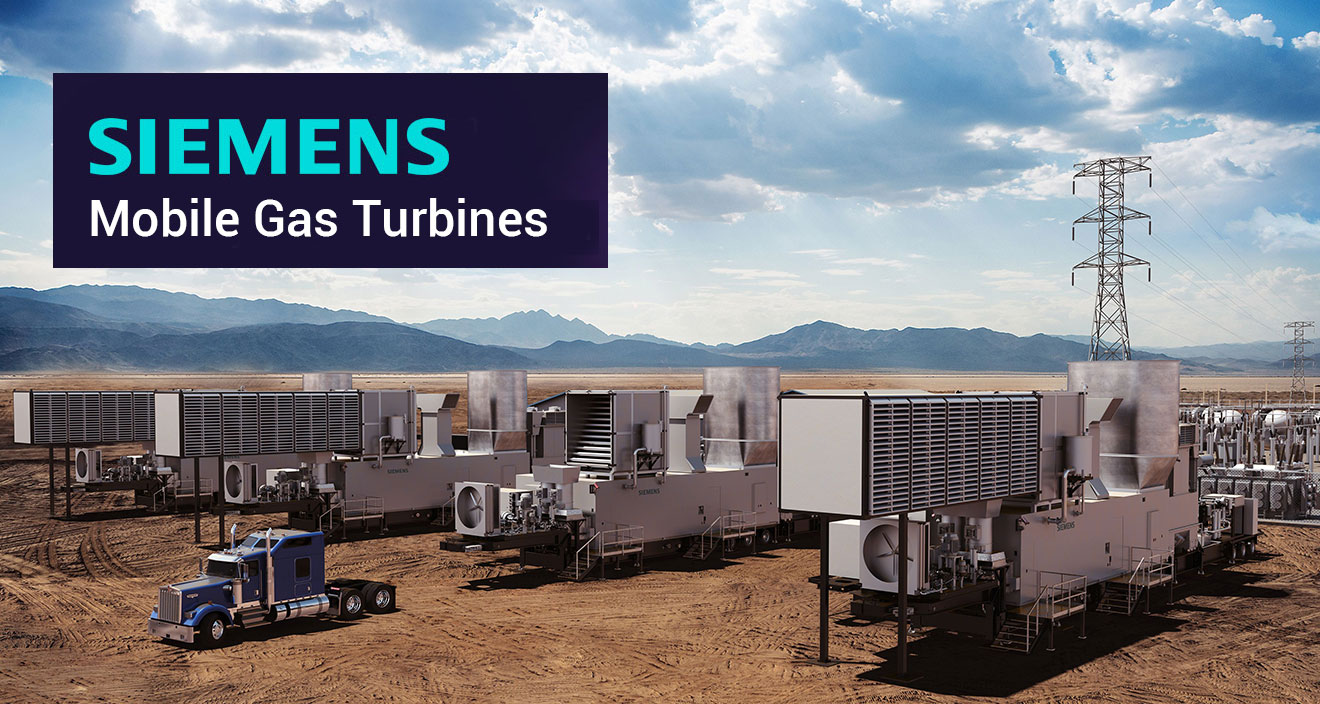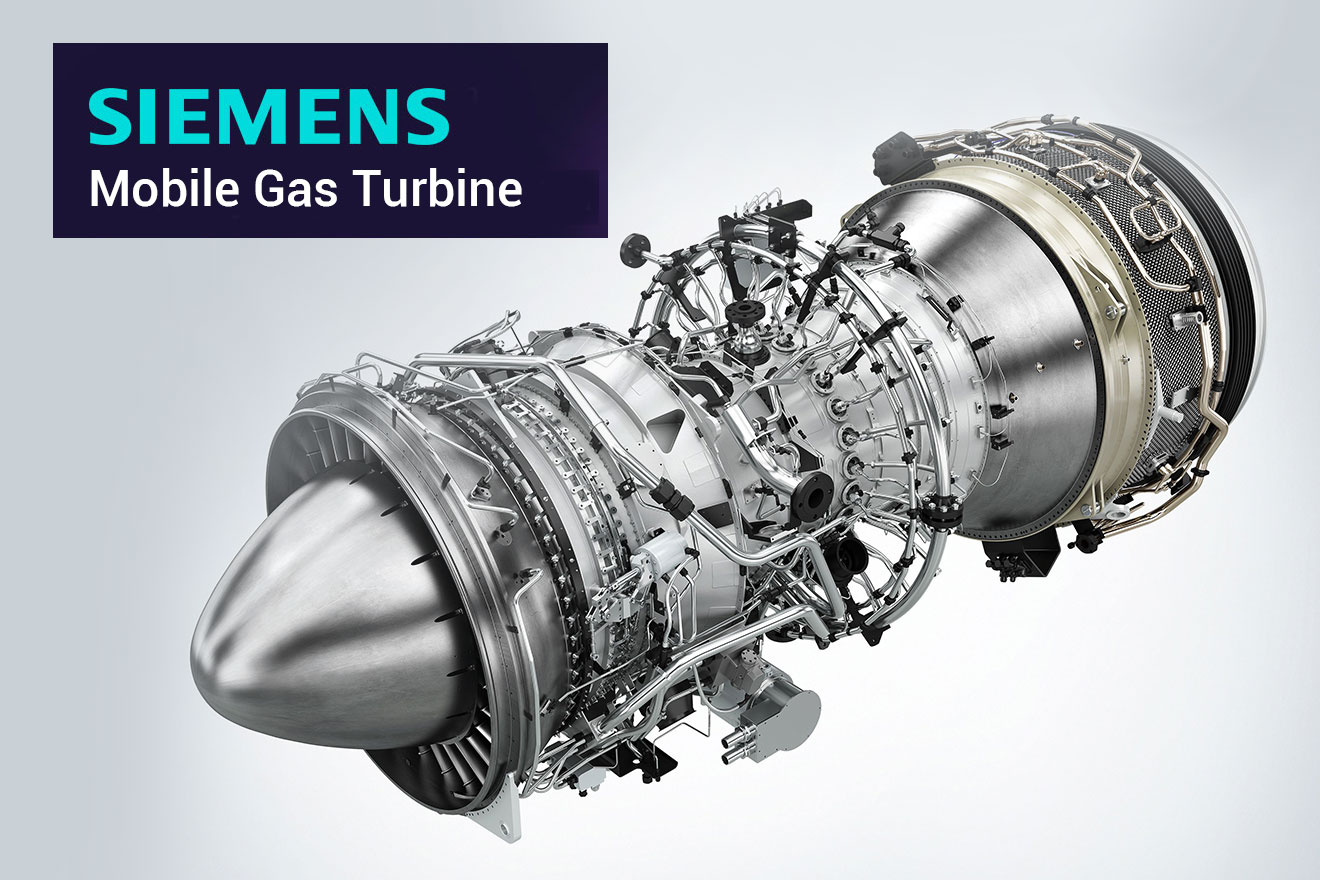
Siemens new 44-megawatt aeroderivative gas turbine for mobile power generation
Most powerful mobile unit on the market
- Immediate power to the grid using proven technology
- Easy transport by air, land or sea
- Fast delivery and installation for customers who need power quickly
A product has been added to the Siemens gas turbine portfolio: The SGT-A45 TR mobile unit addresses the growing market for fast power. With an electrical generating capacity of up to 44 megawatts, this aeroderivative gas turbine is packaged for rapid deployment and can be installed in less than two weeks. Its design features outstanding power density, high fuel efficiency and excellent operational flexibility. This makes it particularly beneficial for customers with urgent power needs or in regions with less developed infrastructures.
Imagine the possibilities:
- Have reliable Power generation installed within a mere 2 weeks - anywhere any time
- Remove at any time and place somewhere else when needed
- Quick Temporary Electrical Power for Coal fired Power Stations transitioning phases
- Temporary Powering Hydrogen Generation
- Implementations are endless for transitioning to a CO2 free future

Analysis of Gas Power Generation
Gas power generation, particularly using natural gas, plays a significant role in the global energy mix due to its efficiency, reliability, and relatively lower carbon emissions compared to other fossil fuels like coal and oil. This analysis examines the current state of gas power generation, its benefits, challenges, technological advancements, and the emerging practice of blending natural gas with hydrogen to reduce carbon emissions.
1. Current State of Gas Power Generation
Global Adoption:
- Widespread Use: Natural gas is a key energy source worldwide, accounting for approximately 24% of global electricity generation. It is particularly dominant in countries like the United States, Russia, and several European nations.
- Combined Cycle Plants: Combined cycle gas turbine (CCGT) plants are the most common form of gas power generation, offering high efficiency by using both gas and steam turbines in a single power plant.
Types of Gas Power Plants:
- Open Cycle Gas Turbines (OCGT): These are simpler and faster to start but less efficient, typically used for peak load generation where rapid response is needed.
- Combined Cycle Gas Turbines (CCGT): These are more efficient and commonly used for base-load and intermediate-load generation. CCGT plants can achieve efficiencies of over 60%, making them one of the most efficient forms of fossil fuel power generation.
2. Benefits of Gas Power Generation
Efficiency and Flexibility:
- High Efficiency: Modern gas turbines, particularly in combined cycle configurations, offer high efficiency, converting a significant portion of the fuel’s energy into electricity.
- Quick Ramp-Up: Gas power plants can start up and reach full power more quickly than coal or nuclear plants, making them ideal for balancing intermittent renewable energy sources like wind and solar.
Lower Carbon Emissions:
- Cleaner than Coal: Natural gas emits about 50-60% less CO₂ than coal when burned for electricity, making it a relatively cleaner fossil fuel option.
- Lower Particulate Emissions: Gas power generation produces fewer particulates, sulfur dioxide (SO₂), and nitrogen oxides (NOx) compared to coal, resulting in lower air pollution and associated health impacts.
Reliability and Energy Security:
- Stable Supply: Natural gas provides a reliable source of energy that can operate 24/7, making it an essential part of the energy mix for ensuring grid stability and energy security.
- Diverse Applications: In addition to electricity generation, natural gas is used in heating, industrial processes, and as a feedstock for chemicals, contributing to its strategic importance.
3. Challenges of Gas Power Generation
Environmental Impact:
- Methane Emissions: Methane, the primary component of natural gas, is a potent greenhouse gas with a global warming potential many times greater than CO₂. Methane leakage during extraction, transportation, and storage can significantly offset the climate benefits of using natural gas over coal.
- Carbon Emissions: While cleaner than coal, natural gas still contributes to carbon emissions, which must be addressed to meet global climate targets.
Market Volatility:
- Price Fluctuations: Natural gas prices can be volatile, influenced by factors such as geopolitical events, supply and demand dynamics, and weather conditions. This volatility can impact the economics of gas power generation.
- Supply Chain Vulnerability: The natural gas supply chain, including pipelines and LNG terminals, is vulnerable to disruptions from natural disasters, geopolitical tensions, and infrastructure failures.
Infrastructure and Investment:
- Capital Costs: Building new gas power plants and associated infrastructure, such as pipelines and storage facilities, requires significant capital investment. Additionally, the long lifespan of these assets can lock in carbon emissions for decades.
- Transition to Low-Carbon Economy: As countries aim to reduce carbon emissions, there is growing pressure to transition away from fossil fuels, including natural gas. This could lead to stranded assets if gas infrastructure becomes obsolete.
4. Blending Natural Gas with Hydrogen
As the world seeks to decarbonize energy systems, blending hydrogen with natural gas offers a pathway to reduce carbon emissions while leveraging existing infrastructure. This section explores the potential and challenges of using hydrogen in gas power generation.
The Role of Hydrogen:
- Hydrogen as a Clean Fuel: Hydrogen, when burned, produces only water vapor, making it a zero-emission fuel at the point of use. When blended with natural gas, it can reduce the carbon intensity of power generation.
- Blending Ratios: Hydrogen can be blended with natural gas in varying proportions, typically ranging from 5% to 20% by volume in current infrastructure without significant modifications. Higher blending ratios or pure hydrogen use would require upgrades to turbines, pipelines, and storage systems.
Benefits of Hydrogen-Natural Gas Blends:
- Carbon Reduction: Even small percentages of hydrogen in the gas mix can lead to meaningful reductions in CO₂ emissions from power generation.
- Utilizing Existing Infrastructure: Blending hydrogen with natural gas allows the use of existing gas pipelines, storage facilities, and power plants, reducing the need for new infrastructure investments.
- Support for Renewable Energy: Hydrogen can be produced from renewable energy sources (green hydrogen), effectively storing excess renewable electricity and providing a low-carbon fuel for power generation.
Challenges and Considerations:
- Production Costs: Hydrogen, particularly green hydrogen produced via electrolysis, is currently more expensive than natural gas. Scaling up production and reducing costs are critical challenges for widespread adoption.
- Infrastructure Compatibility: While low levels of hydrogen can be blended with natural gas without major changes, higher concentrations or pure hydrogen use require significant infrastructure upgrades. These upgrades include materials that can handle hydrogen’s smaller molecules and higher diffusivity.
- Efficiency Losses: Hydrogen has a lower energy density by volume compared to natural gas, meaning that more hydrogen is needed to produce the same amount of energy. This could impact the overall efficiency of power plants using hydrogen-natural gas blends.
- Safety Concerns: Hydrogen is more flammable than natural gas and requires careful handling and safety measures to prevent leaks and explosions.
5. Technological Advancements
Advanced Gas Turbines:
- Hydrogen-Compatible Turbines: Manufacturers are developing gas turbines capable of running on higher hydrogen blends or even 100% hydrogen. These turbines are designed to handle the different combustion characteristics of hydrogen while maintaining efficiency and reducing emissions.
- Carbon Capture and Storage (CCS): CCS technology can be integrated with gas power plants to capture CO₂ emissions before they are released into the atmosphere. This technology is particularly relevant for blue hydrogen production, where hydrogen is produced from natural gas with carbon capture.
Power-to-Gas (P2G) Technology:
- Hydrogen Production: P2G technology converts excess renewable electricity into hydrogen via electrolysis, which can then be blended with natural gas for power generation. This approach offers a way to store renewable energy and provide a flexible, low-carbon fuel source.
- Grid Balancing: P2G can also play a role in balancing supply and demand in the electricity grid by converting surplus renewable energy into hydrogen during periods of low demand and using it for power generation when demand is high.
6. Economic and Market Considerations
Cost Competitiveness:
- Natural Gas: Natural gas is currently a cost-competitive source of electricity generation, particularly in regions with abundant supply. However, as carbon pricing and environmental regulations become stricter, the cost competitiveness of natural gas may diminish.
- Hydrogen Integration: The economics of blending hydrogen with natural gas depend on the cost of hydrogen production, which is currently higher than natural gas. However, as hydrogen production scales up and costs decrease, hydrogen-natural gas blends could become more economically viable.
Policy and Regulation:
- Incentives and Subsidies: Government incentives, such as subsidies for hydrogen production and carbon pricing, will play a crucial role in driving the adoption of hydrogen-natural gas blends in power generation.
- Regulatory Frameworks: Clear regulatory frameworks are needed to support the safe and efficient integration of hydrogen into the natural gas network, including standards for blending ratios, safety protocols, and infrastructure upgrades.
7. The Future of Gas Power Generation
Transition Fuel:
- Bridging the Gap: Natural gas is often seen as a transitional fuel that can help bridge the gap between coal and renewables. Its role in the energy mix is likely to evolve as the world moves towards low-carbon and zero-carbon energy systems.
- Decarbonization Pathways: The integration of hydrogen into gas power generation offers a pathway to decarbonize the sector while maintaining the reliability and flexibility that natural gas provides. As technology advances and costs decrease, hydrogen could play an increasingly important role in the future energy mix.
Long-Term Viability:
- Stranded Assets Risk: As countries commit to net-zero emissions targets, the long-term viability of natural gas power generation without significant decarbonization measures (such as hydrogen blending or CCS) is uncertain. There is a risk that natural gas infrastructure could become stranded assets if it is not adapted for low-carbon operations.
- Integration with Renewables: The future of gas power generation will likely involve greater integration with renewable energy sources, either through direct blending with hydrogen or through supporting technologies like CCS and P2G.
Conclusion
Gas power generation remains a critical component of the global energy mix due to its efficiency, flexibility, and lower carbon emissions compared to other fossil fuels. However, its future role will depend on the ability to further reduce its environmental impact through innovations such as hydrogen blending and carbon capture.
The integration of hydrogen with natural gas offers a promising pathway to decarbonize gas power generation while leveraging existing infrastructure. While there are challenges related to cost, infrastructure compatibility, and safety, ongoing technological advancements and supportive policies could make hydrogen-natural gas blends

